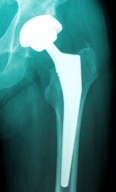Cemented or Uncemented Hip Replacements: Which is your best choice?
Medically Reviewed by Eric Heimberger, MD
South Carolina plays a pivotal role in hip joint replacements. In September 1940, Orthopedic Surgeon Dr. Austin Moore performed the United States’ first metal hip joint replacement in Columbia, SC. “In the last 70 years, orthopedic specialists have introduced many improvements and developments to benefit hip replacement patients,” says Dr. Eric Heimberger of McLeod Orthopaedics Seacoast. “Most hip replacements include 2 pieces: a cup that fits into the hip socket and a stem that inserts into the leg bone (femur) and fits into the cup.”
From the earliest repairs by Dr. Moore, these two components have been cemented in place — until the mid-1980s when the technique of inserting the pieces in place without cement was introduced.
This new approach triggered considerable discussion about which method was best. Surveys of articles related to this topic have been published in the US, Sweden and Finland among others. In general, the reviews conclude that there is little discernible difference over the longer term between the two approaches in terms of complications and needed revisions – particularly for people aged 55 or older.
There are, however, some elements about each approach that may make them more desirable for the patient or the surgeon.
Cemented:
- There seems to be less pain.
- Better short-term medical results.
- Tend to have more problems with the stem piece loosening.
- Frequently used for older, less active people.
- Used for people with osteoporosis or weak bones.
Uncemented (or Cementless):
- Might be better for younger, more active people. Hip joint replacements are being performed on younger people that are hoping for 20 years before another replacement surgery (revision) is needed.
- Recovery takes longer because the bone has to grow attached to the metal pieces.
- These patients are likely to experience some thigh pain while the bone is growing into place.
FINAL THOUGHT
Any decision, about which approach is most appropriate, will depend on the patient’s age, general health and any other medical problems he or she may have. Individual surgeons may have a preference for one type over the other, based on their training, experience and best practices.
To find an orthopedic surgeon, click here.
Sources include: McLeod Health, National Institutes of Health, Patients.co.uk, Acta Orthopedica, Journal of Bone & Joint Surgery, Current Concepts in Joint Replacement.
-
McLEOD REGIONAL MEDICAL CENTER FLORENCE
843-777-2000 -
McLEOD DARLINGTON
843-777-1100 -
McLEOD DILLON
843-774-4111 -
McLEOD LORIS
843-716-7000 -
McLEOD SEACOAST
843-390-8100 -
McLEOD CHERAW
843-537-7881 -
McLEOD CLARENDON
803-433-3000



-
McLEOD REGIONAL MEDICAL CENTER FLORENCE
843-777-2000 -
McLEOD DARLINGTON
843-777-1100 -
McLEOD DILLON
843-774-4111 -
McLEOD LORIS
843-716-7000 -
McLEOD SEACOAST
843-390-8100 -
McLEOD CHERAW
843-537-7881 -
McLEOD CLARENDON
803-433-3000
 Find a Doctor
Find a Doctor  Locations
Locations  Services
Services 